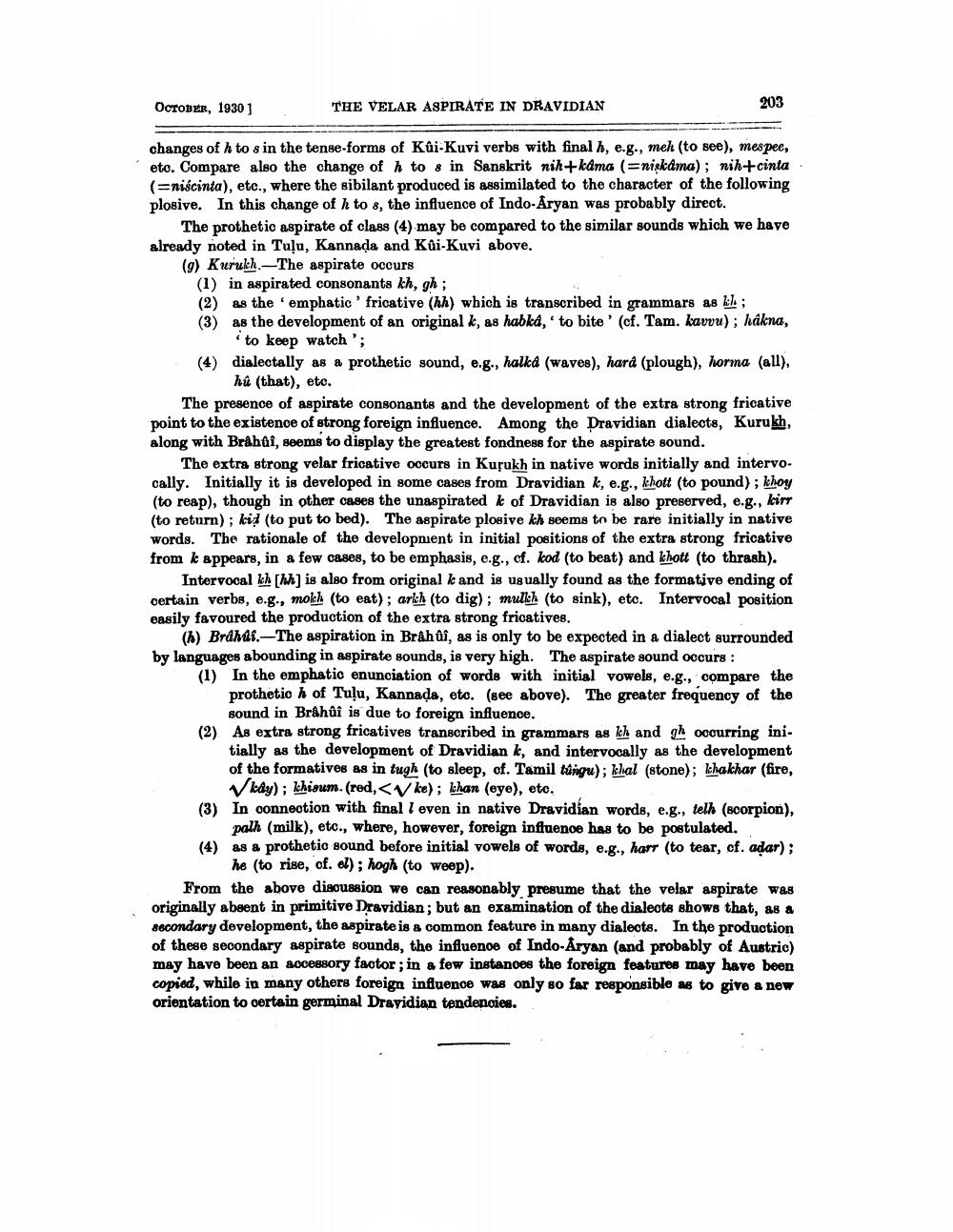________________
OCTOBER, 1930)
THE VELAR ASPIRATE IN DRAVIDIAN
203
changes of h to s in the tense-forms of Kûi-Kuvi verbs with final h, e.g., meh (to see), mespee, eto. Compare also the change of h to 8 in Sanskrit nih+kama (=nixkama); nih cinta (=niścinta), etc., where the sibilant produced is assimilated to the character of the following plosive. In this change of h to 8, the influence of Indo-Aryan was probably direct.
The prothetic aspirate of class (4) may be compared to the similar sounds which we have already noted in Tulu, Kannada and Kai-Kuvi above.
(9) Kurukh.-The aspirate occurs
(1) in aspirated consonants kh, gh; (2) as the emphatic' fricative (hh) which is transcribed in grammars as kl ; (3) as the development of an original k, as habka, to bite' (cf. Tam, kavvu); hákna,
to keep watch'; (4) dialectally as a prothetic sound, e.g., halka (waves), hard (plough), horma (all),
hů (that), etc. The presence of aspirate consonants and the development of the extra strong fricative point to the existence of strong foreign influence. Among the Dravidian dialects, Kurukh, along with Brahi, seems to display the greatest fondness for the aspirate sound.
The extra strong velar fricative occurs in Kurukh in native words initially and intervocally. Initially it is developed in some cases from Dravidian k, e.g., khott (to pound); khoy (to reap), though in other cases the unaspirated k of Dravidian is also preserved, e.g., kirt (to return); ki? (to put to bed). The aspirate plosive kh seems tn be rare initially in native words. The rationale of the development in initial positions of the extra strong fricative from k appears, in a few cases, to be emphasis, e.g., cf. kod (to beat) and khott (to thrash).
Intervocal kh [hh) is also from original k and is usually found as the formative ending of certain verbs, e.g., mokh (to eat); arkh (to dig); mutih (to sink), etc. Intervocal position easily favoured the production of the extra strong fricatives.
(h) Brdhai.-The aspiration in Bråhûs, as is only to be expected in a dialect surrounded by languages abounding in aspirate sounds, is very high. The aspirate sound occurs :
(1) In the emphatio enunciation of words with initial vowels, e.g., compare the
prothetic h of Tuļu, Kannada, eto. (see above). The greater frequency of the
sound in Bråhûi is due to foreign influence. (2) As extra strong fricatives transcribed in grammars as kh and gh occurring ini.
tially as the development of Dravidian k, and intervocally as the development of the formatives as in tugh (to sleep, of. Tamil túngu); khal (stone); khakhar (fire,
kay); khisum (red,< ke); khan (eye), etc. (3) In connection with final leven in native Dravidian words, e.g., telh (scorpion),
palh (milk), etc., where, however, foreign influenoe has to be postulated. (4) as a prothetic sound before initial vowels of words, e.g., har (to tear, cf. adar);
he (to rise, of. el); hogh (to weep). From the above discussion we can reasonably presume that the velar aspirate was originally absent in primitive Dravidian; but an examination of the dialects shows that, as a secondary development, the aspirate is a common feature in many dialoots. In the production of these secondary aspirate sounds, the influence of Indo-Aryan (and probably of Austric) may have been an accessory factor; in a few instances the foreign features may have been copied, while in many others foreign influence was only so far responsible as to give a new orientation to certain germinal Dravidian tendencies.




